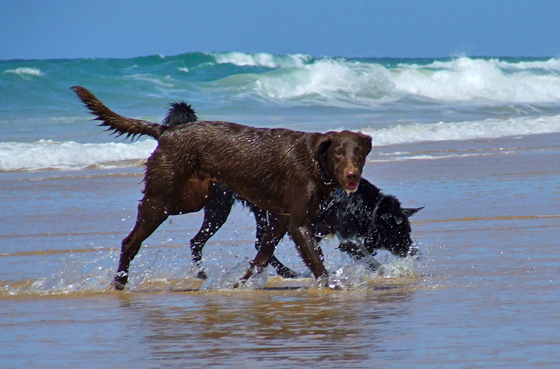This post is part of the series in response to Dunbar’s 2012 Australian seminars. See index.
Along with Dunbar’s criticisms of the four quadrants of operant conditioning, he also criticised learning theory for being “mostly irrelevant” to pet dog training. ‘These days’, learning theory is common knowledge for most dog trainers, but Dunbar considers it to be mostly irrelevant in the ‘real world’ of dog training.

Outside of the laboratory is a whole wide world of training environments and possible rewards. So why are we so caught up on learning theory?
Much of learning theory has been established by computer-use of reinforcements and punishments. To Dunbar, this means the findings of learning theory, as delivered a lab, is only relevant to lab settings. In a laboratory, the subjects are normally rats or pigeons, computers control the training, and the animals are contained. In the real world of dog training, humans are not computers (they are inconsistent), dogs are more complex than rats and pigeons, dogs escape from people (aren’t contained), and dogs bite!
But humans have an advantage: Humans have voice and can moderate their tone to reward and punish. Computers cannot use verbal rewards or punishments, and so research on verbal feedback is almost entirely neglected. Dunbar encourages verbal feedback to train recalls, and claims it is easy to do. He believes that verbals are more expressive than clicks, jerks and shocks. Verbals can describe how desirable behaviour was and also an appropriate alternative behaviour.
Punishment may be effective in a laboratory, but (to quote his handout) “people are inconsistent and so the dog quickly learns those times when he will not be punished, i.e., when the owner is physically-absent (dog at home alone), physically-present but functionally absent (dog off leash), or physically-present but mentally absent (owner day-dreaming or making a phone call).” On top of this, owners normally have bad timing, and dogs learn to be separated from their owners to avoid punishments. (See also: Dunbar’s thoughts on punishment.) Dunbar described people as “screwed before we start” if we seek to replicate laboratory settings in real-world dog training.
Dunbar presented a set of pros and cons between humans and computers.
Computer Pros:
- There is no “fuzzy logic” – the criteria for rewards or punishments are clear.
- They are consistent in monitoring behaviours and delivering feedback.
- Are able to compute a variable schedule on an ongoing basis.
- Able to deliver effective punishments, especially because the animal is confined.
Computer Cons:
- Do not have qualitative assessment ability.
- Use continuous and variable schedules always, which is not useful for puppies.
- Cannot form a relationship with the animal.
- Feedback is difficult to program into a computer
Human Pros:
- Can qualitatively evaluate behaviour.
- Can use their voice to reward and punish in a more naturally expressive way.
- Are able to teach dogs verbals and use them to guide new behaviours.
- Can reinforce practically – more ‘right’ behaviours get better rewards.
- Are creative!
Human cons: (And when you read this, you’ll think “How did we ever train anything?”)
- Set unrealistic and unclear criteria/rules (or haven’t set criteria)
- Often don’t pay attention / don’t observe and supervision
- Lack of feedback.
- Inconsistent by nature.
- Bad timing
- Lack of ongoing computing power (i..e schedules)
In summary: Laboratory environments are nothing like dog training. Dog trainers, in the real world, can’t emulate what is done in a laboratory. Instead, dog trainers can do it better.
Further reading:
For Dunbar’s own description on the ‘uselessness’ of learning theory, he has an article on DogStarDaily: “Tweaking Learning Theory for Human Brains”.
On a similar but different note, Denise Fenzi talks about rewarding mistakes. This is the kind of creative, qualitative responses that humans are capable of, that makes them better than a machine!

I partially agree with your thoughts about dog training. You are right that not always trainings can happen in a laboratory. But there are certain other factors for which you need help of a lab to give training to your dogs. For example, while training, if you want to do any test (medical) of your dog, then you will definitely need a laboratory.
Pingback: Schedules of Reinforcement | Some Thoughts About Dogs